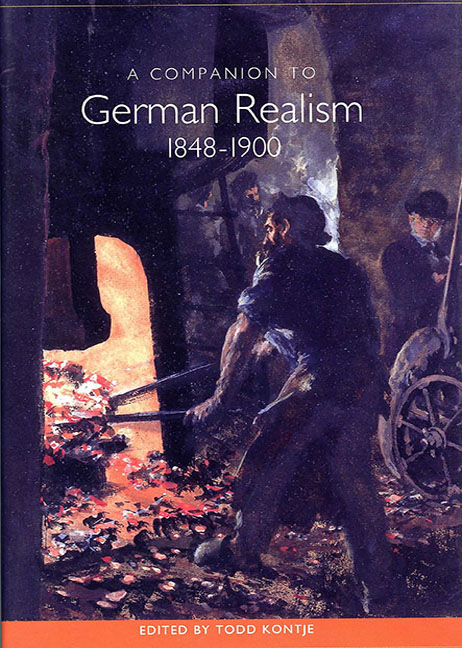Book contents
- Frontmatter
- Contents
- Preface
- Introduction: Reawakening German Realism
- Adalbert Stifter's Brigitta, or the Lesson of Realism
- Mühlbach, Ranke, and the Truth of Historical Fiction
- “In the Heart of the Heart of the Country”: Regional Histories as National History in Gustav Freytag's Die Ahnen (1872–80)
- A Woman's Post: Gender and Nation in Historical Fiction by Louise von François
- Friedrich Spielhagen: The Demon of Theory and the Decline of Reputation
- Wilhelm Raabe and the German Colonial Experience
- From National Task to Individual Pursuit: The Poetics of Work in Freytag, Stifter, and Raabe
- Das Republikanische, das Demokratische, das Pantheistische: Jewish Identity in Berthold Auerbach's Novels
- E. Marlitt: Narratives of Virtuous Desire
- The Appeal of Karl May in the Wilhelmine Empire: Emigration, Modernization, and the Need for Heroes
- Making Way for the Third Sex: Liberal and Antiliberal Impulses in Mann's Portrayal of Male-Male Desire in His Early Short Fiction
- Effi Briest and the End of Realism
- Works Cited
- Notes on the Contributors
- Index
Adalbert Stifter's Brigitta, or the Lesson of Realism
Published online by Cambridge University Press: 27 April 2017
- Frontmatter
- Contents
- Preface
- Introduction: Reawakening German Realism
- Adalbert Stifter's Brigitta, or the Lesson of Realism
- Mühlbach, Ranke, and the Truth of Historical Fiction
- “In the Heart of the Heart of the Country”: Regional Histories as National History in Gustav Freytag's Die Ahnen (1872–80)
- A Woman's Post: Gender and Nation in Historical Fiction by Louise von François
- Friedrich Spielhagen: The Demon of Theory and the Decline of Reputation
- Wilhelm Raabe and the German Colonial Experience
- From National Task to Individual Pursuit: The Poetics of Work in Freytag, Stifter, and Raabe
- Das Republikanische, das Demokratische, das Pantheistische: Jewish Identity in Berthold Auerbach's Novels
- E. Marlitt: Narratives of Virtuous Desire
- The Appeal of Karl May in the Wilhelmine Empire: Emigration, Modernization, and the Need for Heroes
- Making Way for the Third Sex: Liberal and Antiliberal Impulses in Mann's Portrayal of Male-Male Desire in His Early Short Fiction
- Effi Briest and the End of Realism
- Works Cited
- Notes on the Contributors
- Index
Summary
Began to think about realism over a decade ago, when I was planning a course on the nineteenth century. Most of the texts I wanted to include were regarded by knowledgeable literary scholars as “realist,” and so I decided to design the course rather conveniently along the lines of literary texts reflecting social reality — in particular, the social reality of the German middle class, although there were several texts that did not really fit well in this framework. In reflecting on realism and on previous theories of realism, however, I began to feel some discomfort. It struck me that in the secondary literature there were two ways in which realism was approached. One set of theorists employs realism as I did at that time: to refer to a specific period during the nineteenth century when writers dealt with the social reality of the newly established or self-conscious middle class. Particularly important for these theorists are long novels, and the names that are usually associated with realism in this sense are almost always British or French: Dickens, Thackeray, Stendhal, Balzac, Flaubert. In the scholarship about German realism one usually finds the term realism accompanied by an adjective, sometimes “poetic,” sometimes “bourgeois,” sometimes “programmatic”; and it is usually applied to such writers as Keller, Storm, Freytag, and Fontane, occasionally also to Stifter or Meyer and others. This secondary literature usually concedes that Fontane is the only classical realist in the European sense of the word; and some would argue that even he is atypical, since his writing career began when European realism was already waning, and since he deals primarily with aristocratic demise and not with middle-class life. A chief representative for a theory of nineteenth-century realism would be someone such as René Wellek, who, in a seminal essay of 1961 titled “The Concept of Realism in Literary Scholarship,” defines realism simply as “the objective representation of contemporary social reality.”
The other type of realism is less specific with regard to epochs and considers realism to be a general characteristic of literary texts. In this sense it can be applied to the entire tradition of Western literature from Homer to the present and includes a conceptual apparatus that extends from mimesis as a concept among the ancients to socialist realism in the twentieth century.
- Type
- Chapter
- Information
- A Companion to German Realism 1848-1900 , pp. 29 - 52Publisher: Boydell & BrewerPrint publication year: 2002



